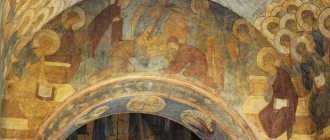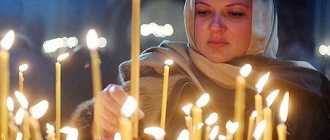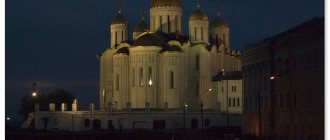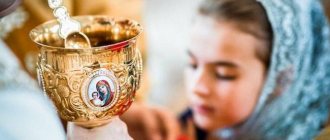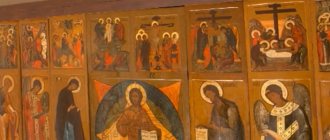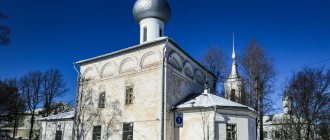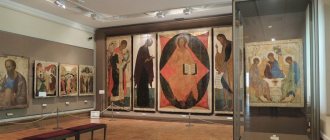History and attribution
According to the generally accepted version, the icons were found in 1918 in a barn at the Assumption Cathedral on Gorodok in Zvenigorod under a pile of firewood by the restorer of the All-Russian Commission for the Preservation and Revealing of Old Russian Painting G. O. Chirikov.
This message has the character of a legend. As noted by D. A. Sedov, an employee of the Zvenigorod Museum, there are no reports on this find, which was unusual for the work of the TSHR Commission, and the history of the discovery of icons in the barn is known from the report of N. D. Protasov and the publications of I. E. Grabar. In addition, the date of receipt of the icons at the Kremlin restoration workshops (October 8, 1918) does not coincide with the period of the Central State Historical Museum expedition to Zvenigorod, which began on October 14. According to the Tretyakov Gallery archive, after the discovery of the Zvenigorod rank, a search was undertaken for the missing Deesis icons: on December 21, N.D. Protasov visited the Korallovo estate near Zvenigorod in connection with information about the possible arrival of ancient icons from the Assumption Cathedral in the local church.
At a conference dedicated to the 1000th anniversary of the baptism of Rus', the head of the sector of the history of ancient Russian art of the Institute of Art History, Doctor of Historical Sciences O. I. Podobedova said that the icons of the Zvenigorod rank were not discovered by restorers: they were given to them by priest Dmitry Krylov:
| Father Dmitry acted solely at his own peril and risk, without the blessing of the dean or bishop. An act of this kind in the poorly educated clerical environment of a provincial parish could lead to undesirable consequences for him. The young priest, who was in Zvenigorod, apparently on an internship, immediately began to have troubles. In order not to completely ruin his life, the above legend was invented - especially for publication. |
CONTENTS Zvenigorod rank
of Christ Pantocrator
archangel Michael
Apostle Paul
The icons of the Zvenigorod rank were uncovered by specialists of the Commission for the Preservation and Disclosure of Ancient Painting in 1918-1919. and transferred to the State Historical Museum, from which they entered the collection of the Tretyakov Gallery in 1930.
In 1926, I. E. Grabar in the journal “Issues of Restoration” published an article “Andrei Rublev: An Essay on the Artist’s Creativity Based on the Data of Restoration Works of 1918-1925,” in which he attributed the Zvenigorod rank as the work of Andrei Rublev based on the features of painting that are related to the icons with Rublev’s Trinity and frescoes of the Assumption Cathedral in Vladimir. Despite the brevity of Grabar’s argument, his attribution “has received universal recognition” and most other art historians agree with him, recognizing the icons of the Zvenigorod rank as “undoubtedly belonging to Andrei Rublev.”
Various researchers date the Zvenigorod rank from the end of the 14th century to the 1420s. According to Academician V.N. Lazarev, “in terms of its style, this is such a mature work that it cannot be attributed to the early period of Rublev’s work. It could have arisen only after the painting of the Vladimir Assumption Cathedral, in other words, after 1408.” He dates the Zvenigorod rank to 1410-1415. He is supported by M.A. Ilyin (c. 1417), K. Onash (c. 1409) and other researchers.
Researchers note that based on the size of the icons of the Zvenigorod rank, it was intended for a very large unknown church and, based on the measurements, this is neither the Assumption Cathedral on Gorodok, nor the Cathedral of the Nativity of the Virgin Mary of the Savvino-Storozhevsky Monastery in Zvenigorod. At the same time, according to the inventory of the Assumption Cathedral in Gorodok in 1693, in the local row of the 17th century iconostasis and along the pillars there was part of the icons of a certain ancient Deesis order.
In the Assumption Cathedral
No less mysterious is the origin of Andrei Rublev himself. Biographical information about the great artist is so insignificant that researchers simply speculate on some pages of his life. His ancestral roots could be in Radonezh, and in Pskov, and in the Tver regions, and in Belozersk, and in others. Not a native Muscovite, Rublev as an artist could take his first steps on Moscow soil in the Trinity-Sergius Monastery, where he took monastic vows. Or he could have done it in the grand-ducal art workshops of the Kremlin, where he worked on decorating books with miniatures. It is possible to combine these hypotheses by suggesting that the layman Rublev left the Kremlin workshops in the late 1390s to become a monk in the monastery of Sergius of Radonezh. And only after that he became known as a master of large iconographic forms. And this could have happened, for example, at the instigation of Savva Storozhevsky, who in 1399 moved from the Trinity Monastery to Mount Storozha near Zvenigorod. Prince Yuri of Zvenigorod invited Savva there, asking the elder to found a new monastic monastery.
Prince Yuri, the second son of Dmitry Donskoy, was considered by his father’s will to be a contender for the Moscow throne, the heir of his elder brother, Grand Duke Vasily I. Zvenigorod, the largest of the Moscow region cities at that time, was the capital of his appanage principality. Through the efforts of Yuri, in those years it turned into one of the cultural centers of the Moscow land. The ambitious prince of Zvenigorod, who competed with his older brother, did not want to yield to Moscow in anything. He ensured the greatness of his appanage capital with a broad program of construction and decoration of the city, inviting for this the best craftsmen - architects, artists, craftsmen. He erected a powerful, impregnable wooden fortress on a hill above the Moscow River (princely Kremlin - Gorodok). It contains the white-stone Assumption Cathedral, a wonderful example of early Moscow architecture (unfortunately, it has now lost much of its beauty). In the suburban Savvin Monastery he built a stone Nativity Cathedral. The main thing in this architectural and artistic program was, of course, the spiritual component.
As the godson of Sergius of Radonezh and the spiritual son of Savva Storozhevsky, a student of both of them, a church benefactor and temple builder, Prince Yuri was deeply imbued with the idea of the religious transformation of Rus'. The inspirer of this national revival on the paths of holiness, the unity of the people in an impulse towards Christ, towards transformation into Holy Rus' was Sergius of Radonezh. He also became one of the main ideologists of the liberation of Rus' from Tatar-Mongol slavery. Sergius blessed Dmitry Donskoy for a mortal battle with the Tatar horde of Mamai. Both the Radonezh abbot himself and his contemporaries considered this battle on the Kulikovo field to be a great sacrificial feat of Rus', the martyrdom of Russian soldiers “for the holy churches and for the Orthodox faith.” The entire era in which Rublev lived is permeated with the memory of the significant event of the Kulikovo victory.
As the son of Dmitry Donskoy and heir to the Moscow throne, Prince Yuri saw his duty as continuing the work of his father and “mentor of the Russian land” Sergius - to unite Rus' for further victories. This is evidenced by the program of fresco painting of his Assumption Cathedral in Gorodok. This painting was created around 1401-1404. Researchers have long had no doubt that some of the frescoes belong to the brush of monk Andrei. This is the very first major work of the famous master that has come down to us. Perhaps the name of the promising artist, a Trinity monk, was suggested to Prince Yuri by Savva Storozhevsky. The content of the temple murals was, of course, approved by Yuri Zvenigorodsky himself.
Over the centuries, little has survived. The best fragments of the frescoes are located on the eastern pillars of the temple, delimiting the altar part, on their faces facing the center of the cathedral. Rublev is the author of the medallions with the martyrs Florus and Laurus. These two images closed the frieze, which encircled the entire eastern, altar wall of the temple and contained images of Christian martyrs for the faith. If we remember that Sergius gave his blessing for the Battle of Kulikovo on August 18, on the day of remembrance of Florus and Laurus, then the intention of the temple painting will be clear. At least a significant part of it is the glorification of the sacrificial feat of the Russian people who went to the Kulikovo field to drink the mortal cup there and accept the crowns of martyrdom “for their friends.”
In all the future work of Andrei Rublev, “an extraordinary icon painter,” a deep thinker and theologian, “exceeding everyone in wisdom,” a humble ascetic, a man of prayer and a most lyrical artist, this theme of heroism, drama and sacrifice of the era will run through. An amazing time in the history of the country, when scattered, wounded Rus' gathered itself together and restored its spiritual strength.
Description
The Zvenigorod rank is written on large boards (158-160 by 108-110 cm), the half-length images on it exceed human measure. Based on the traditional iconography of the Deesis, initially the Zvenigorod tier (except for the three surviving icons) could also include the icons “Our Lady”, “John the Baptist”, “Archangel Gabriel”, “Apostle Peter”, “Basily the Great” and “John Chrysostom”.
According to academician V.N. Lazarev, the icons “at first glance amaze with the extraordinary beauty of their cold, light colors. Blue, pink, indigo, faded violet and cherry tones are given in such impeccably correct combinations with the gold background that purely musical associations involuntarily arise in those contemplating the icon.” According to M. V. Alpatov, during the creation of the Zvenigorod rank, Rublev’s talent as a colorist was revealed:
| Russian icon painting before Rublev did not know such a wealth of shades and halftones. Byzantine icon painting did not know it either. |
Christ Pantocrator
The painting on the icon of Christ Pantocrator has survived in fragments. This is the most damaged of the icons of the Zvenigorod rank. On the face there is a crack along the old gesso, on the hair and beard there are abrasions of the top paint layer. An expert on ancient Russian art N.A. Demina notes that the Savior on Rublev’s icon is
| ...the embodiment of typically Russian good looks. Not a single element of the face is overly emphasized - everything is proportional and consistent: he is Russian, his eyes are not exaggerated, his nose is straight and thin, his mouth is small, the oval of his face, although elongated, is not narrow, there is no asceticism at all, his head has a thick mass of hair rises with calm dignity on a strong, slender neck. The most significant thing about this new look is the look. It is directed directly at the viewer and expresses lively and active attention to him; he feels a desire to delve into a person’s soul and understand him |
The gospel in the hand of the Savior is lost. Based on the surviving fragments of the codex in the hand of the Apostle Paul, it is assumed that on the icon of the Savior it was very large and occupied a significant place in the composition of the Deesis. Professor V.A. Plugin suggests that the inscription in the opened Gospel was associated with the theme of the Last Judgment. Based on the stylistic similarity with the 15th century icon of the Pantocrator from the Trinity-Sergius Lavra (located in the Tretyakov Gallery collection), which is close in time to the Zvenigorod Savior, a possible text option is “Come to Me, all you who labor and are heavy laden, and I will give you rest...” (Matthew 11 :28-29), which at first is not found in ancient Russian art and became characteristic only of the works of the 15th-16th centuries.
Academician V.N. Lazarev notes that the icon of the Savior shows a good knowledge of the tradition of Byzantine painting of the 14th century, but the image is devoid of Byzantine severity - in Andrei Rublev, “the image of Christ is so humanized that it completely loses its abstract cult character.”
"They were begged"
Monk Andrei was one of Sergiev’s many “chicks of the nest”, a direct successor of his prayerful exploits and service to his neighbor, which meant the entire Orthodox people of Rus'. It is not surprising that in the 1420s the already venerable elder Andrei was called from Moscow to the Trinity Monastery, where a great event took place. Sergius of Radonezh is glorified as a saint, and his newfound relics are transferred to the new stone Trinity Church. Prince Yuri Zvenigorodsky again acted as trustee of the construction. But the sovereign icon painters Andrei Rublev and Daniil Cherny received the order for painting the temple and its iconostasis not from him, but from the Trinity abbot Nikon. “The Legend of the Holy Icon Painters” testifies that “wonderful virtuous elders and painters” were “begged” by Nikon to take on this great work. And he adds: both icon painters “were formerly in obedience to the Monk Nikon.” From this detail we know that Andrei and Daniel were once listed as monks of the Sergius Monastery, after the death of Sergius himself (in 1392). And in another source, Daniel is called Andrei’s teacher. Most likely, this was the spiritual guidance of an older, more experienced monk by a younger, novice monk. After all, both were icon painters and, probably, when Andrei appeared in the monastery, they immediately “found” each other, shared one cell for two, worked together, fasted and prayed - until the end of their lives.
Angel. Miniature of Andrey Rublev. Gospel of Khitrovo, XIV century.
Why did Abbot Nikon have to beg them? Both were already old. Perhaps they were overcome by infirmities and illnesses. Or maybe in the last years of their lives they intensified their prayer work, completing or significantly limiting their artistic work. But it is precisely this detail - “they were begged for” - that suggests that Rublev’s creative flowering and maturity as an icon painter were left behind. After all, an artist who still feels the creative forces within himself and has not said the “most important thing” cannot refuse work that allows him to express precisely this “most important thing.” The main thing for Rublev was his “Trinity”. And it was not born in the mid-1420s, as this icon was previously dated, but earlier. The new “praise” to Sergius from the famous icon painters was the Church of the Holy Trinity, painted and decorated under their leadership. A crowded team of artists was involved in this work. Andrei and Daniil only controlled this “choir”, in which each of the talented icon painters, gathered from everywhere by Nikon, led his own part. Rublev was responsible for the overall design and drawing of the compositions in this iconostasis: most likely, he acted here as a flag bearer, i.e., he outlined the design of the icons. But not only. For example, the icon “The Appearance of an Angel to the Myrrh-Bearing Women” definitely says that Rublev also created new, previously unprecedented iconographic subjects.
The Trinity iconostasis can still be seen in the cathedral. This is the only iconostasis associated with the name of Andrei that has reached us in its entirety. But the frescoes were knocked down and rewritten in the 17th century. One can only hope with confidence that the later paintings repeat the layout and composition of the murals of the 1420s.
archangel Michael
Archangel Michael is depicted in iconography found in Byzantine painting from the beginning of the 14th century. In terms of the nature of the image, it is close to the angels on the frescoes of the central nave of the Assumption Cathedral in Vladimir. The icon has lost gold on the angel's chest, and there are traces of scratches on the face.
The Archangel is dressed in a shining azure tunic, almost completely hidden by the folds of a “swirling” pink cloak. The head is gently tilted to the right, brown curly hair is tied with a ribbon to match the chiton. Art critic M.V. Alpatov notes:
| In his half-figure, outlined by smooth, softly flowing contours, there is so much human charm, as if in his earthly appearance he had found the highest bliss and he does not know the desire for the “heavenly” world. |
ANDREY RUBLEV
The earliest surviving works of A.R. to the present day. time, the icons of the belt Deesis, the so-called, are considered. Zvenigorod rank (about 1400). The icons of the Savior, architect, have been preserved. Mikhail and ap. Paul, which were discovered in 1918 by the Zvenigorod expedition of the All-Russian Commission for the Preservation and Discovery of Monuments of Ancient Painting by I. E. Grabar near the Assumption Cathedral on Gorodok in Zvenigorod (Zvenigorod was the inheritance of Prince Yuri of Zvenigorod, godson of St. Sergius of Radonezh); discovered in 1918-1919; in 1929 transferred to the Tretyakov Gallery. According to the inventory of the cathedral in 1693, some of the ancient icons of the Deesis order were in the local row of the 17th century iconostasis. and at the pillars of the temple. The rank consisted of no less than 7, possibly 9, icons in the event that the icon of St. mentioned in the inventory. Basil the Great belonged to the ancient Deesis. There is no written evidence of the authorship of these icons, but images analogous to Crimea can be seen on the 1408 frescoes of the Assumption Cathedral in Vladimir, all researchers attribute them to the most significant works of A.R. The accepted dating of the icons is based on the date of the consecration of the Assumption Cathedral in the town, a number of researchers (V.G. Bryusova, I.E. Grabar, V.N. Lazarev, V.V. Filatov, etc.) also associate the paintings with the name of A.R.
Apostles and angels. St. Andrey Rublev. Fragment of the composition “The Last Judgment”. Assumption Cathedral in Vladimir. 1408 Apostles and angels. St. Andrey Rublev. Fragment of the composition “The Last Judgment”. Assumption Cathedral in Vladimir. 1408
The painting on the icon of the Savior has been preserved in fragments. The face is painted with transparent melts of warm ocher, a light glow on the forehead, around the eyes, on the neck, devoid of bright highlights, softly emphasizes the volumes, a clear line marks the design of small eyes and slightly raised eyebrows. A barely noticeable turn of the head creates the feeling of a slight movement directed forward, towards the person ahead. The image of the Gospel has not survived. According to V.N. Sergeev (Sergeev. 1981. pp. 200-201), icons close in time (for example, the icon of the Savior, mid-15th century, inserted into the Trinity-Sergius Monastery by Thomas Simonov (Tretyakov Gallery)) allow us to reconstruct the text of the Gospel of Matthew: “” (Matthew 11. 28-29), not previously found in Russian. art, but has become traditional. for works of the XV-XVI centuries. The iconography, type and character of the image of the “Zvenigorod Savior” reveals a deep knowledge of the Byzantines. traditions of the 14th century, at the same time A.R. created an image expressing Russian. the national ideal is boundless love and patience.
Arch. Mikhail from the Zvenigorod rank is close in design, silhouette, spatial composition and character of the image to the angels from the painting of the central nave of the Assumption Cathedral in Vladimir. The meek, ideally beautiful face has a special intonation of inner deep agreement with the will of God, characteristic of the images of A.R. The color combinations of the shining azure chiton, the bandage in the hair, the ferns of the wings and the pink cloak, as if permeated with light, emphasize the luminosity of the image. Lick up. Paul, with a high forehead, a small slightly curved nose, deep-set eyes and clearly protruding cheekbones, is painted in more relief. Behind the silence and tranquility of the appearance of the ap. Paul can sense the enormous life and spiritual experience, the depth of knowledge revealed to him, which gives a shade of sorrow to the expression of his face. The silver-pearl color scheme, in which the apostle’s clothes are painted, creates a mood consonant with his contemplative image. Judging by the fairly well-preserved icons of the arch. Mikhail and ap. Pavel, color characteristics played a big role in the composition of the Zvenigorod rank.
In 1405, according to the Trinity Chronicle, Theophanes the Greek, Prokhor from Gorodets and A.R. painted the Annunciation Cathedral of the Moscow Kremlin (the frescoes have not survived; the current building was built in 1484-1489). Simultaneously with the painting, according to I.E. Grabar (chronicle evidence has not survived), icons of the Deesis and festive rites of the iconostasis were painted. A.R.’s brushes traditionally included 7 icons: the Annunciation, the Nativity of Christ, the Presentation, the Baptism, the Transfiguration, the Raising of Lazarus, and the Entry of the Lord into Jerusalem. L.A. Shchennikova, on the basis of historical evidence of the destruction of the interior decoration of the Annunciation Cathedral during a fire on June 21, 1547, proved that the modern. The iconostasis is prefabricated (the Deesis and holidays come from different ensembles) and was erected after 1547, denying A.R.’s participation in the creation of the existing iconostasis. This opinion was supported by a number of scientists (G. I. Vzdornov, G. V. Popov, O. S. Popova, E. S. Smirnova, etc.). However, this view not accepted by other researchers (V.N. Sergeev, E.Ya. Ostashenko), who note the stylistic similarity of the icons from the Annunciation Cathedral to the paintings of the Assumption Cathedral in Vladimir, the icons of the Zvenigorod rank and “St. Trinity."
An entry in the Trinity Chronicle for 1408 reports that “by order of the Great Prince, the masters Danilo the icon painter and Andrei Rublev” began painting the Assumption Cathedral in Vladimir (12th century). The renovation of the frescoes of the ancient cathedral, damaged by fire in 1237 during Batu's invasion, was undertaken in anticipation of the arrival of a new metropolitan to Rus'. The order was so important that the chronicle notes the exact date of the start of work - May 25. The painting of 1408 has been partially preserved on the vaults under the choir, on the domed pillars, in the altar, in the south. nave. In zap. In part of the middle nave, the composition “The Last Judgment” has been preserved. On the vault, in a halo of glory, in shining golden robes, the Savior is depicted. His right hand is raised in an inviting gesture, his left hand is lowered, balancing and at the same time imparting swiftness to the movement of the figure. The seraphim and cherubim are inscribed in the outer ring of glory, i.e., in tradition. composition of “The Last Judgment” A.R. uses the new iconography “Savior in Power”. Under the arch, on the cheek. arches depicting the Virgin Mary and St. John the Baptist, standing before the throne of the Lord in prayer for the human race, the ancestors Adam and Eve fall at the foot of the throne. The internal outline of the contours of the figures forms an arc open upward, with Etymasia in the center. Following the tradition of the 12th century, on the slopes of the central west. The vault under the choir depicts the apostles sitting with open books in their hands, behind them is a host of angels. Gentle faces, concentrated, attentive glances, and high spirituality of appearance distinguish the images of the apostles. They appear not as impartial judges, but as faithful, loving disciples, anxiously and inspiredly awaiting the kingdom of light and truth promised from the ages. On the slopes of the west arches of trumpeting angels, awakening the whole of heaven to judgment - the age of this world is over, and the angels (in the center of the western arch) are rolling up the scroll of heaven. At the zenith of the arch in the medallion there is written a symbolic composition “The souls of the righteous in the hand of God” - the Divine right hand with tiny figures in it. The general enlightened structure of the painting is repeated in groups of saints, righteous women, and the soulful image of the apostle. Peter, leading the righteous to paradise (northern slope of the southern nave). The basis of the artist’s painting style is a free, absolutely precise drawing.
Ap. Peter. Work of Rev. Andrey Rublev. Fragment of the composition “The Last Judgment”. Assumption Cathedral in Vladimir. 1408
Ap. Peter. Work of Rev. Andrey Rublev. Fragment of the composition “The Last Judgment”. Assumption Cathedral in Vladimir. 1408
Simultaneously with the paintings of 1408, icons of the huge 3-tier iconostasis of the Assumption Cathedral were probably created, which in the 18th century. were transferred to the village. Vasilyevskoye near Shuya, so-called Vasilievsky rank. They suffered greatly from restoration. 9 icons of the Deesis order (the Savior in Powers, the Mother of God, St. John the Baptist, Arch. Michael, Arch. Gabriel, Apostle John the Theologian, Apostle Andrew the First-Called, St. Gregory the Theologian) are in the Tretyakov Gallery, 4 icons (Apostle Peter, Apostle Paul, St. Basil the Great, St. Nicholas the Wonderworker) - in the State Russian Museum. Of the 25 icons of the festive series, the Annunciation, the Descent into Hell, the Ascension - Tretyakov Gallery, the Presentation, the Baptism - the State Russian Museum have been preserved. The prophetic row of the iconostasis of the Assumption Cathedral in Vladimir (the icons of Prophet Zephaniah and Prophet Zechariah (GRM) have been preserved) is the oldest known. The creation of a high iconostasis with a prophetic row is a fundamentally new phenomenon in artistic culture, which can be associated with the name of A.R. In 3 rows of icons, the history of the economy of the salvation of the human race is consistently revealed from the OT (prophets) to the NT (holidays) and the eschatological completion ( Deesis). The deep theological concept of the high iconostasis, the development of a new iconographic program of the Deesis order, the introduction of the “Savior in Powers” icon as the centerpiece of the Deesis testify to the exceptional significance of the image - “speculation in colors” in the spiritual life of the late. XIV - beginning XV century A.R. and Daniel, during work in the Assumption Cathedral, made a copy of the Vladimir Icon of the Mother of God (miniature in the Litsevoy chronicle vault (Osterman volume - BAN. 31. 7. 30. T. 2. L. 1442, 2nd half 16th century).
Holy Trinity. St. Andrey Rublev. Icon. 1412 (?), 20s XV century (?) (TG)
Holy Trinity. St. Andrey Rublev. Icon. 1412 (?), 20s XV century (?) (TG)
The most famous and famous work of A.R. is the image of the Holy Trinity. The icon comes from the local row of the Trinity Cathedral of the Trinity-Sergius Lavra (since 1929 in the Tretyakov Gallery); was revered in the monastery as miraculous. In the “Tale of the Holy Icon Painters” there is evidence that Abbot. Nikon asked “to paint an image of the Most Holy Trinity in praise of his father Saint Sergius.” The authorship of A.R. is also evidenced by the resolution of the Stoglavy Council of 1551, where it was specified to paint the Holy Trinity “as Greek icon painters wrote and as Andrei Rublev wrote” (Chapter 41. Question 1). There are two opinions on the issue of dating the icon: a number of scientists suggest that it was painted for the wooden church of the Trinity Monastery, built by the abbot. Nikon after the invasion of Edigei, and date the icon to 1412 (V.N. Lazarev, G.V. Popov, E.S. Smirnova - 1st quarter (10th) of the 15th century), others determine 20s XV century, linking its origin with the stone cathedral of the monastery, founded in 1422 (V. I. Antonova, E. K. Guseva, N. A. Demina, G. I. Vzdornov, M. A. Ilyin, T. N. Manushina and others). In the 16th century Tsar Ivan IV Vasilyevich the Terrible made a contribution to the monastery by decorating the icon with a basma gold frame with gold crowns and enamel tsats, which were later transferred to the frame of the time of Tsar Boris Godunov (TSL Sacristy). Based on the centuries-old experience of Christ. iconography, A.R. created the image of the Holy Trinity, embodying in colors the doctrine of One God in Three Persons. The Old Testament story about the appearance of 3 strangers to Abraham (Genesis 18), interpreted as the Old Testament revelation of the Holy Trinity (Ambros. Mediol. De Abrahamo. II 11. 79; Aug. De temp. Sermo 67. 2; 70. 4) or as the appearance of the Lord with 2 angels (Ian. Chrysost. 42.2, 43.1), already in the III-IV centuries. attracted the attention of Christ. artists. It is found in Roman paintings. catacombs, on ancient Eucharistic vessels, in early Christian paintings. and Byzantine. temples. In the depiction of the Holy Trinity, artists emphasized the appearance of the Second Person of the Trinity, highlighting the central figure (by size, baptized halo, scroll in hand). The new iconography created by A.R. was a generalization of the long history of the development of the plot. The image of the Holy Trinity of A.R., perfect in beauty, absorbed all the spiritual and artistic experience of the Byzantines. and Old Russian art, has become an unparalleled expression in the colors of Orthodoxy. teachings of the Church about the Holy Trinity.
Fragment of the painting on the slope of the altar window of the Spassky Cathedral of the Andronikov Monastery. 1426–1427 (?)
Fragment of the painting on the slope of the altar window of the Spassky Cathedral of the Andronikov Monastery. 1426–1427 (?)
In the icon of A.R. there are no images of Abraham and Sarah, a servant with a calf. Traditional the composition lost everything everyday, temporary, historically specific, focusing on the contemplation of the mystery of Divine unity. The basis of the composition of the icon is a circle, in which are inscribed the figures of Angels sitting at a meal (table), on which there is a bowl with the head of a calf - the image of the Sacrifice, which gives the image the character of an endlessly lasting peace, saturated with internal movement. Postures, gestures, mutual bowing of heads, direction of gazes echo the main circular movement, and background details are subordinated to it - chambers, a tree, a hill, which acquire symbolic meaning, revealing the character of each of the 3 Hypostases. The architectural structure behind the left Angel indicates the First Hypostasis, the Creator of heaven and earth; tree behind the middle Angel, dressed in a cherry tunic with a clave and a blue himation, traditional. the clothes of Christ - for the Second Hypostasis, the Son of God; the slide behind the right Angel, a symbol of the heavenly spiritual ascent - to the Holy Spirit. From ancient times, the meal in the house of Abraham was understood as Christ. artistic tradition as a prototype of the Eucharist (Archbishop Sergius (Golubtsov), L. A. Uspensky, Archpriest A. Saltykov). In the icon, the meal takes on the appearance of a church altar with the Eucharistic chalice on it. The internal outlines of the figures repeat the lines of the bowl, in which the central Angel appears to be immersed. Deep, sonorous, iridescent tones of cherry, blue, light green, golden shining ocher are united by flickering reflexes of bluish spaces. The construction of the composition is of particular importance. The side figures turn out to be several. brought forward, emphasizing the depth of space of the composition, also subject to circular movement.
In the 20s XV century A.R. and Daniil decorated the stone Cathedral of the Trinity-Sergius Monastery with paintings. According to the life of St. Nikon, during his lifetime, immediately after the completion of the construction of the new temple, probably in 1425-1427, A.R. and Daniil were not just invited by the abbot, but “begged the father.” They led a large team of icon painters who, in addition to painting the icons for the iconostasis. The painting has not survived; in the 17th century. it was replaced due to dilapidation, but it can be assumed that the main themes go back to the painting of the 15th century. The iconostasis has been preserved, but since now. While the painting of icons is hidden under a layer of darkened drying oil (they were cleared in the 50s of the 20th century), the question of their authorship remains open.
The last work of A.R. is the painting of the Spassky Cathedral of the Andronikov Monastery, 1426-1427. (?); discovered during the restoration in 1952. The story about the construction and decoration of the Spassky Cathedral with paintings is contained in the life of St. Sergius of Radonezh. Currently Only fragments of the ornament on the slopes of 2 altar windows have been preserved.
Among the works attributed to A.R., mention should be made of miniatures and initials of the Khitrovo Gospel (RGB), ca. 1400 (?). There is no consensus on the attribution of this monument. The authorship was assumed to be both A. R. (I. E. Grabar, M. V. Alpatov, N. A. Demina, etc.) and Feofan the Greek (Yu. A. Olsufiev, V. N. Lazarev, O. S. . Popov), as well as Daniil (G.I. Vzdornov). Scientific restoration of the Gospel in 1985-1989. (under the direction of G.Z. Bykova) suggests the presence of indistinguishable manners that belonged to several. masters, one of whom could have been A.R. (G.V. Popov, L.A. Shchennikova).
Based on stylistic analysis, fragments of frescoes on the altar barrier of the Nativity Cathedral of the Savvino-Storozhevsky Monastery with the image of saints are also attributed to A.R. (ZIAKhM).
Apostle Paul
The Apostle Paul is depicted slightly bending towards the Savior. His face is painted in more relief compared to other icons of the Zvenigorod rank. It has been suggested that it was written not by Andrei Rublev, but by his student. The face of the apostle is filled with sorrow and peace. To emphasize his contemplative image, the clothes are painted in silver and pearl tones. Both hands of the Apostle Paul hold a large, slightly open codex.
M. V. Alpatov writes about the icon of the Apostle Paul:
| This sage with a high open forehead bows his head not so much because he prays to Christ, but because he is immersed in thought. The soft flow of wide-arched contours emphasizes harmony and completeness in its appearance. |
Andronikov Monastery
Carrying out commissioned works in different places of the Moscow land, monks Andrei and Daniil invariably returned to their native Spaso-Andronikov Monastery on the Yauza. Now it is almost the center of the capital, but then Moscow was located within the current Boulevard Ring and the Andronikov monastery was a suburb. The life of Sergius of Radonezh (involved in the establishment of this monastery) depicts the monk Andrei as an honest elder who enjoys honor and authority in the monastery. He was one of the “cathedral elders” who, together with the abbot, managed the life of the monastic community. It was Andrei who in 1427 became one of the inspirers of the construction of the stone Spassky Cathedral in the monastery. As V.A. Plugin writes, Rublev “played the role of not only the leading master - performer of artistic works, but also a kind of ideologist who determined much in the system and structure of the ensemble” of the cathedral.
The repose of the icon painter Andrei Rublev in the Andronikov Monastery. Book miniature
The Andronikov Monastery itself, which now houses a museum named after the great icon painter, is a place of peace and quiet. Slowly walking around the temple, darkened by time, but still just as beautiful and picturesque, you can imagine how the hand of the humble monk Andrei touched these stones. How he sat on the platform above the entrance to the temple and painted his last work - the image of the Savior Not Made by Hands (as depicted in a 17th-century miniature). And how, having already left this temporary life, “in a blaze of glory” he appeared in the cell of the ill Daniel, calling him to “eternal and endless bliss...”.
